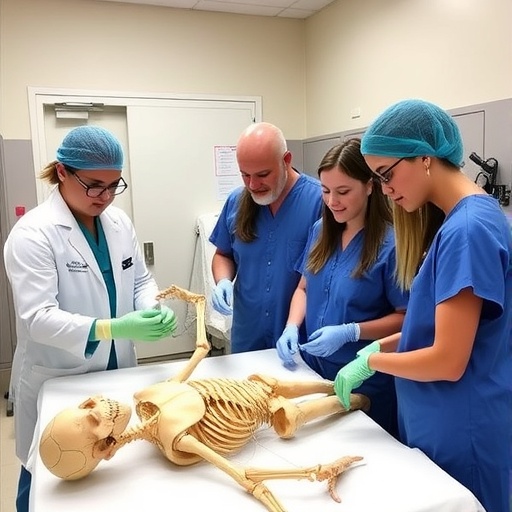In recent years, the field of biomedical engineering has seen a significant evolution in its educational methodologies. One area that has garnered attention is the teaching of anatomy to students within this discipline. A novel study conducted by Bradshaw, Perotti, and Kassab in 2025 has highlighted the advantages of utilizing human cadavers as an integral part of the learning process. The findings from this research present a compelling narrative about the effectiveness of hands-on experience in anatomical education for engineering students.
This study, published in the Biomedical Engineering Education journal, meticulously examines the experiences of biomedical engineering students exposed to human cadavers during their anatomical training. In the quest to innovate and enhance educational practices, the researchers collected qualitative data from a diverse cohort of students who participated in the dissection and study of cadavers. Their insights revealed a profound appreciation for the real-world context that cadaveric study provided, offering a stark contrast to traditional textbook approaches.
For many students, the opportunity to interact directly with human anatomy proved to be an indispensable aspect of their education. The hands-on experience facilitated a deeper understanding of complex structures, physiological functions, and the spatial relationships within the human body. This experiential learning model allowed students to bridge the gap between theoretical knowledge and practical application, a crucial skill in the field of biomedical engineering where precision and understanding of human anatomy directly impact device development and patient care.
Furthermore, the emotional and psychological responses of students engaged with cadavers were noted. Many reported feelings of gratitude for the opportunity to learn from donated bodies, with a sense of respect and responsibility underscoring their experience. This emotional engagement is vital in cultivating empathy and a comprehensive understanding of the human condition, integral traits for aspiring biomedical engineers who often work closely with medical technologies directed at improving patient outcomes.
The researchers identified that the inclusion of cadaver studies not only enhanced anatomical knowledge but also improved students’ confidence in their skills. Participants expressed that mastering dissection techniques and understanding anatomical variations equipped them with indispensable tools for their future careers. The mastery of such technical skills not only bolsters their academic profiles but also fosters a readiness to engage with clinical practices where such knowledge is crucial.
The investigation revealed that traditional instructional methods often leave students yearning for a more tactile learning experience. While textbooks, 3D models, and virtual simulations provide valuable information, they frequently fall short of replicating the intricacies and nuances of human anatomy. Cadaveric study fills this void, offering a dynamic learning environment where students can explore, inquire, and discover in ways that enhance retention and understanding.
Additionally, the findings pointed to the collaborative nature of cadaveric dissection exercises, wherein students worked in groups to maximize their learning experiences. This collaborative aspect not only promoted active learning but also fostered essential teamwork skills that are crucial in multidisciplinary settings. Students reported that sharing observations and insights with peers during dissections contributed significantly to their overall learning experience, illustrating the communal benefit of engaging with human anatomy in a shared space.
As educational institutions increasingly recognize the importance of experiential learning, the study emphasizes the need to integrate cadaveric study into biomedical engineering curriculums. The researchers advocate for the continued evolution of educational frameworks that prioritize hands-on experiences alongside theoretical instruction. By adopting such models, institutions can prepare graduates who are not only knowledgeable but also skilled and empathetic practitioners ready to tackle contemporary healthcare challenges.
Moreover, the ethical considerations surrounding cadaver use are also addressed in the study. Participants expressed a heightened awareness of the ethical responsibilities that accompany the utilization of human bodies for educational purposes. Institutions must ensure that the procurement of cadavers is conducted ethically and respectfully, fostering a culture of gratitude among students for the contributions of those who have chosen to donate their bodies to science.
Lastly, the ramifications of this research extend beyond individual educational institutions; they have implications for the biomedical engineering field at large. Enhancing the anatomical knowledge of engineers can translate into innovations in medical devices, wearable technology, and surgical tools that are more effective and user-friendly. Thus, universities may play a pivotal role in shaping the future of biomedical engineering through their educational approaches, ultimately leading to advancements that could significantly improve patient care and outcomes.
In conclusion, Bradshaw, Perotti, and Kassab’s 2025 study serves as a clarion call for the integration of cadaveric studies into biomedical engineering education. By fostering practical skills, enhancing empathy, and encouraging collaborative learning, such approaches will not only benefit students but also the broader healthcare landscape. As the demand for skilled professionals in biomedical engineering continues to grow, educational practices must also evolve to meet the challenges of tomorrow.
Subject of Research: Biomedical Engineering Education and the Use of Cadavers
Article Title: Biomedical Engineering Students Report Positive Experiences Learning Anatomy from Human Cadavers
Article References:
Bradshaw, E.L., Perotti, L.E. & Kassab, A. Biomedical Engineering Students Report Positive Experiences Learning Anatomy from Human Cadavers.
Biomed Eng Education (2025). https://doi.org/10.1007/s43683-024-00166-2
Image Credits: AI Generated
DOI: 10.1007/s43683-024-00166-2
Keywords: Biomedical Engineering, Anatomy Education, Cadaver Studies, Experiential Learning, Educational Methodology




